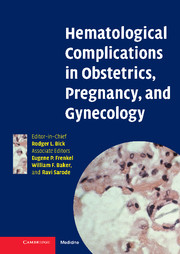Book contents
- Frontmatter
- Contents
- List of contributors
- Preface
- 1 Disseminated intravascular coagulation in obstetrics, pregnancy, and gynecology: Criteria for diagnosis and management
- 2 Recurrent miscarriage syndrome and infertility caused by blood coagulation protein/platelet defects
- 3 Von Willebrand disease and other bleeding disorders in obstetrics
- 4 Hemolytic disease of the fetus and newborn caused by ABO, Rhesus, and other blood group alloantibodies
- 5 Hereditary and acquired thrombophilia in pregnancy
- 6 Thromboprophylaxis and treatment of thrombosis in pregnancy
- 7 Diagnosis of deep vein thrombosis and pulmonary embolism in pregnancy
- 8 Hemorrhagic and thrombotic lesions of the placenta
- 9 Iron deficiency, folate, and vitamin B12 deficiency in pregnancy, obstetrics, and gynecology
- 10 Thrombosis prophylaxis and risk factors for thrombosis in gynecologic oncology
- 11 Low molecular weight heparins in pregnancy
- 12 Post partum hemorrhage: Prevention, diagnosis, and management
- 13 Hemoglobinopathies in pregnancy
- 14 Genetic counseling and prenatal diagnosis
- 15 Thrombocytopenia in pregnancy
- 16 Neonatal immune thrombocytopenias
- 17 The rational use of blood and its components in obstetrical and gynecological bleeding complications
- 18 Heparin-induced thrombocytopenia in pregnancy
- 19 Coagulation defects as a cause for menstrual disorders
- Index
- Plate section
- References
2 - Recurrent miscarriage syndrome and infertility caused by blood coagulation protein/platelet defects
Published online by Cambridge University Press: 01 February 2010
- Frontmatter
- Contents
- List of contributors
- Preface
- 1 Disseminated intravascular coagulation in obstetrics, pregnancy, and gynecology: Criteria for diagnosis and management
- 2 Recurrent miscarriage syndrome and infertility caused by blood coagulation protein/platelet defects
- 3 Von Willebrand disease and other bleeding disorders in obstetrics
- 4 Hemolytic disease of the fetus and newborn caused by ABO, Rhesus, and other blood group alloantibodies
- 5 Hereditary and acquired thrombophilia in pregnancy
- 6 Thromboprophylaxis and treatment of thrombosis in pregnancy
- 7 Diagnosis of deep vein thrombosis and pulmonary embolism in pregnancy
- 8 Hemorrhagic and thrombotic lesions of the placenta
- 9 Iron deficiency, folate, and vitamin B12 deficiency in pregnancy, obstetrics, and gynecology
- 10 Thrombosis prophylaxis and risk factors for thrombosis in gynecologic oncology
- 11 Low molecular weight heparins in pregnancy
- 12 Post partum hemorrhage: Prevention, diagnosis, and management
- 13 Hemoglobinopathies in pregnancy
- 14 Genetic counseling and prenatal diagnosis
- 15 Thrombocytopenia in pregnancy
- 16 Neonatal immune thrombocytopenias
- 17 The rational use of blood and its components in obstetrical and gynecological bleeding complications
- 18 Heparin-induced thrombocytopenia in pregnancy
- 19 Coagulation defects as a cause for menstrual disorders
- Index
- Plate section
- References
Summary
Introduction
Recurrent miscarriage syndrome (RMS) is a common obstetrical problem, affecting over 500,000 women in the USA per year; infertility although less well defined in the population is also a common clinical problem.
Recurrent miscarriage, based upon literature available and our experience is generally due to well defined defects as follows: about 7% are secondary to chromosomal abnormalities, about 10% are due to anatomical abnormalities, about 15% appear due to hormonal abnormalities (progesterone, estrogens, diabetes or thyroid disease), about 6% cannot be explained and the remainder, about 55 to 62%, are due to blood coagulation protein/platelet defects. The approximate prevalence of causes of RMS/infertility are summarized in Figure 2.1. This is in contrast to first time miscarriage, which in about 90% of cases, is due to a chromosomal defect and may effect up to 25 percent of first time pregnancies.
Blood coagulation protein/platelet defects
Recurrent miscarriage syndrome (RMS) due to blood protein or platelet defects may come about through two mechanisms, those disorders associated with a hemorrhagic tendency or those defects associated with a thrombotic tendency. Hemorrhagic (bleeding) defects associated with RMS are very rare, while thrombotic or hypercoagulable/thrombophilic defects are extremely common. The hemorrhagic defects associated with fetal wastage syndrome presumably lead to inadequate fibrin formation, thus precluding adequate implantation of the fertilized ovum into the uterus.
- Type
- Chapter
- Information
- Publisher: Cambridge University PressPrint publication year: 2006
References
- 1
- Cited by



